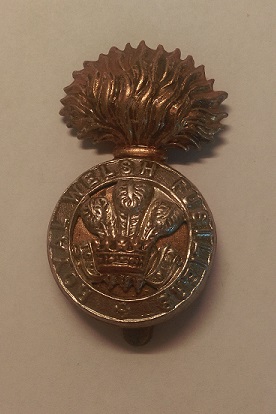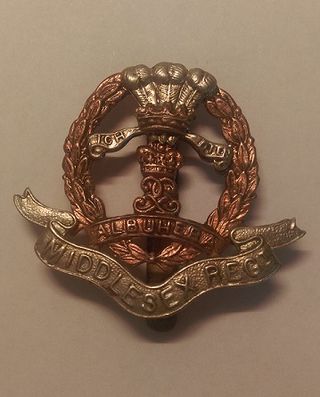
The Royal Welch Fusiliers (Welsh: Ffiwsilwyr Brenhinol Cymreig) was a line infantry regiment of the British Army, and part of the Prince of Wales' Division, that was founded in 1689; shortly after the Glorious Revolution. In 1702, it was designated a fusilier regiment and became the Welch Regiment of Fusiliers; the prefix "Royal" was added in 1713, then confirmed in 1714 when George I named it the Prince of Wales's Own Royal Regiment of Welsh Fusiliers. In 1751, after reforms that standardised the naming and numbering of regiments, it became the 23rd Regiment of Foot (Royal Welsh Fuzileers). In 1881, the final title of the regiment was adopted.

The 53rd (Welsh) Infantry Division was an infantry division of the British Army that fought in both the First and Second World Wars. Originally raised in 1908 as the Welsh Division, part of the Territorial Force (TF), the division saw service in First World War, being designated 53rd (Welsh) Division in mid-1915, and fought in the Gallipoli Campaign and in the Middle East. Remaining active in the Territorial Army (TA) during the interwar period as a peacetime formation, the division again saw action in Second World War, fighting in North-western Europe from June 1944 until May 1945.

The South Staffordshire Regiment was a line infantry regiment of the British Army in existence for only 68 years. The regiment was created in 1881 under the Childers Reforms by the amalgamation of the 38th Regiment of Foot and the 80th Regiment of Foot. The regiment saw service in the Second Boer War, World War I and World War II.

The Lancashire Fusiliers was a line infantry regiment of the British Army that saw distinguished service through many years and wars, including the Second Boer War, the First and Second World Wars, and had many different titles throughout its 280 years of existence. In 1968 the regiment was amalgamated with the other regiments of the Fusilier Brigade – the Royal Northumberland Fusiliers, Royal Warwickshire Fusiliers and the Royal Fusiliers – to form the current Royal Regiment of Fusiliers.

The Essex Regiment was a line infantry regiment of the British Army in existence from 1881 to 1958. The regiment served in many conflicts such as the Second Boer War and both World War I and World War II, serving with distinction in all three. It was formed in 1881 under the Childers Reforms by the amalgamation of the 44th Regiment of Foot and the 56th Regiment of Foot.

The Welch Regiment was an infantry regiment of the line of the British Army in existence from 1881 until 1969. The regiment was created in 1881 under the Childers Reforms by the amalgamation of the 41st (Welch) Regiment of Foot and 69th Regiment of Foot to form the Welsh Regiment, by which it was known until 1920 when it was renamed the Welch Regiment. In 1969 the regiment was amalgamated with the South Wales Borderers to form the Royal Regiment of Wales.

The Dorset Regiment was a line infantry regiment of the British Army in existence from 1881 to 1958, being the county regiment of Dorset. Until 1951, it was formally called the Dorsetshire Regiment, although usually known as "The Dorsets". In 1958, after service in the Second Boer War along with World War I and World War II, the Dorset Regiment was amalgamated with the Devonshire Regiment to form the Devonshire and Dorset Regiment. In 2007, it was amalgamated with the Royal Gloucestershire, Berkshire and Wiltshire Regiment, The Light Infantry and the Royal Green Jackets to form a new large regiment, The Rifles.

The 11th Armoured Division was an armoured division of the British Army which was created in March 1941 during the Second World War. The division was formed in response to the unanticipated success of the German panzer divisions. The 11th Armoured was responsible for several major victories in the Battle of Normandy from in the summer of 1944, shortly after the Normandy landings, and it participated in the Allied advance from Paris to the Rhine, the Rhine crossing in March 1945. It was disbanded in January 1946 and reformed towards the end of 1950. In 1956, it was converted into the 4th Infantry Division.

The King's Shropshire Light Infantry (KSLI) was a light infantry regiment of the British Army, formed in the Childers Reforms of 1881, but with antecedents dating back to 1755. It served in the Second Boer War, World War I and World War II. In 1968, the four regiments of the Light Infantry Brigade amalgamated to form The Light Infantry, with the 1st KSLI being redesignated as the 3rd Battalion of the new regiment.

The 33rd Infantry Brigade was an infantry brigade of the British Army that saw active service in the First World War and home service during the Second World War.

The Middlesex Regiment (Duke of Cambridge's Own) was a line infantry regiment of the British Army in existence from 1881 until 1966. The regiment was formed, as the Duke of Cambridge's Own (Middlesex Regiment), in 1881 as part of the Childers Reforms when the 57th (West Middlesex) and 77th (East Middlesex) Regiments of Foot were amalgamated with the county's militia and rifle volunteer units.

The Suffolk Regiment was an infantry regiment of the line in the British Army with a history dating back to 1685. It saw service for three centuries, participating in many wars and conflicts, including the First and Second World Wars, before being amalgamated with the Royal Norfolk Regiment to form the 1st East Anglian Regiment in 1959 which, in 1964, was further amalgamated with the 2nd East Anglian Regiment, the 3rd East Anglian Regiment and the Royal Leicestershire Regiment to create the present Royal Anglian Regiment.
The 159th Infantry Brigade was an infantry brigade of the British Army. Part of the Territorial Army (TA), the brigade was assigned to the 53rd (Welsh) Infantry Division and served with the division in the early stages of the Second World War until May 1942 when it was transferred to be the motorised infantry element of the 11th Armoured Division. The brigade would serve with the 11th Armoured in North-west Europe from June 1944 to May 1945.

The East Midland Brigade was an infantry brigade of the Territorial Force, part of the British Army, that was raised in 1908. As the name suggests, it commanded infantry battalions recruited in the East Midlands of England: Bedfordshire, Northamptonshire, Cambridgeshire and Hertfordshire. The brigade was an integral part of the East Anglian Division.

The British yeomanry during the First World War were part of the British Army reserve Territorial Force. Initially, in 1914, there were fifty-seven regiments and fourteen mounted brigades. Soon after the declaration of war, second and third line regiments were formed. However, the third line regiments were soon absorbed into the Cavalry Reserve Regiments, to supply replacements for the cavalry and yeomanry. Other horsed regiments in the British Army, during the war, were the regular cavalry regiments and the three regiments belonging to the special reserve: the North Irish Horse, the South Irish Horse and the King Edward's Horse. The senior yeomanry regiments could trace their origins back over 100 years; the oldest regiment, the Royal Wiltshire Yeomanry, had been formed in 1794. The most junior regiment, the Welsh Horse, had only been formed on 18 August 1914, after the start of the war.

The Monmouthshire Regiment was a Territorial infantry regiment of the British Army. Originating in units of rifle volunteers formed in Monmouthshire in 1859, the regiment served in the Second Anglo-Boer War and both World War I and World War II before losing its separate identity in 1967.

The Essex Brigade, later 161st Brigade and 161st Infantry Brigade, was a volunteer infantry formation of the British Army in existence from 1888 until 1941, and again from 1947. It served at Gallipoli and in Palestine during the First World War and returned to Egypt in the early part of the Second World War before transferring to the British Indian Army and redesignated 161st Indian Infantry Brigade. In peacetime and during the wars the brigade was an integral part of the 54th Infantry Division and contained mostly battalions of the Essex Regiment.

The Harold Street drill hall is a former military installation in Hereford, Herefordshire.
The Cheshire Brigade, later 159th (Cheshire) Brigade, was an infantry formation of Britain's Volunteer Force created in 1900. It was carried over into the Territorial Force in 1908 and mobilised on the outbreak of the First World War. It fought at Gallipoli and in Palestine as part of 53rd (Welsh) Division. By the end of the war all its Cheshire units had left and it was composed of one Welsh battalion with the remainder drawn from the British Indian Army. It was not reformed after the war.
10th Battalion, London Regiment (Hackney) was a battalion of the London Regiment, the only all-Territorial Force regiment in the British Army. The battalion existed between 1912 and 1955 and was later re-attached to the Rifle Brigade, Royal Berkshire Regiment and Royal Artillery.

















